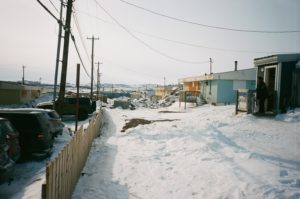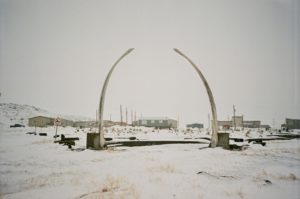
Photograph by Hannah Tollefson
View of Iqaluit, March, 2019.
In a 2017 interview, Madeline Redfern, the then mayor of Iqaluit, described Nunavut as a “dark zone” when it comes to telecommunications provision. Despite the launch of Telesat’s Telstar 19 vantage high throughput satellite that became operational in 2019, connection speeds across the territory of Nunavut lag significantly behind other circumpolar communities, both in Canada and abroad. Nunavummiut experience amongst the lowest connection speeds in the country. They inhabit the high cost, high latency side of the digital divide, and have made calls to remedy the unequal access they face in relation to southern digital realities due to this lack of infrastructural capacity. Living in a telecommunications “dark zone” means making do with slower connection speeds, a fact that foregrounds how the development of infrastructure is a political process which benefits some and not others. In this case, in such a way that is reminiscent of historical and ongoing colonial networks of southern dispossession.
In collaboration with Geronimo Inutiq, a multimedia artist based in Winnipeg, this project aims to provide a forum for youth in Iqaluit to document their experiences of digital connection through the creation of ‘damaged’ field guide. Latency is both an existential condition and a computer user state that youth across the territory of Nunavut face when it comes to their participating in digitally-enabled networks of communication. Delay, equally time-based and resonant across social and cultural domains such as that experienced in accessing Inuktitut language government services, has become inscribed as a taken-for-granted part of their experiences of telecommunications infrastructure.

Photograph by Rafico Ruiz
The then named Frobisher Bay Elementary School, completed by PGL architects in 1976, Frobisher Bay, Northwest Territor. PGL fonds, Canadian Centre for Architecture.
In order to describe how latency is affecting youth in Iqaluit and elsewhere across Nunavut’s “dark zones,” the workshop provides a peer-based forum for youth to document their experiences of infrastructural delay: how does digital slowness affect their definitions of ‘connection’? What stories do these latent infrastructures give rise to, whether of mis, missed, or redirected communication? How might their experiences of the capacities of telecommunications infrastructure in Iqaluit push against discourses of ‘speed’ provided by corporate telecommunications providers? The workshop aims to ‘unsettle’ Nunavut’s place as a “dark zone” of telecommunications provision by collaboratively telling infrastructural stories that, firstly, document experiences of digital delay in Iqaluit, and secondly, in partnership with the workshop’s artist in residence, Geronimo Inutiq, forecast alternative experiences of digital connection that look towards the decolonial futures suggested by community-defined and responsive highspeed broadband. The first workshop is to take place in fall of 2022.





